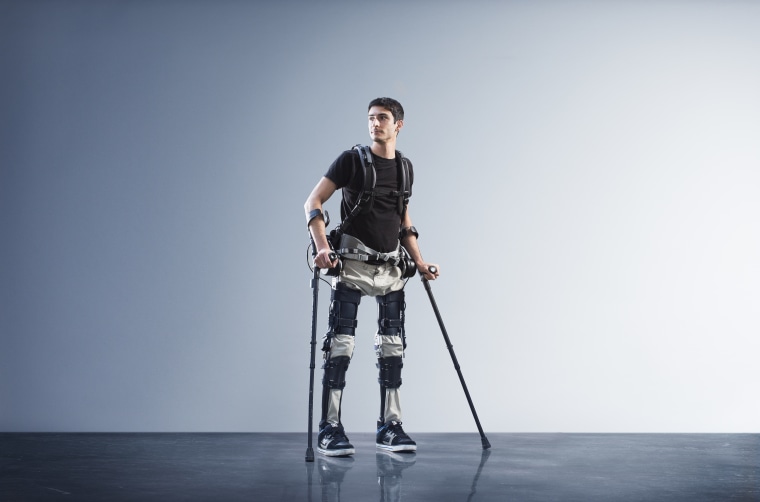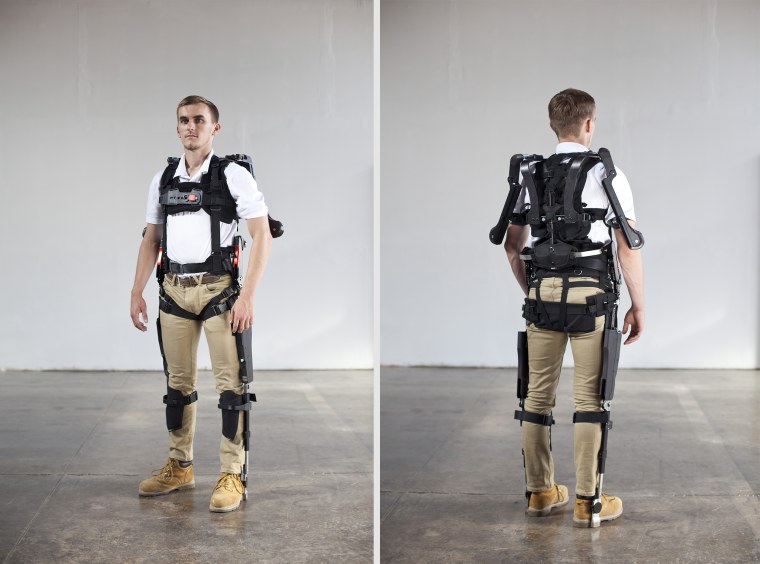Say the term ‘power suit’ and most people think of bold corporate attire. But the expression takes on new meaning when it refers to a powered “exoskeleton,” like Ellen Ripley’s power loader in "Aliens," or Iron Man’s armor from the Marvel films and comic books.
Until a few years ago, such exoskeletons — metal frameworks fitted with motorized "muscles" that can multiply the wearers’ strength far beyond that of normal humans — were entirely fictional. The only real-world exoskeletons were the natural external coverings of animals such as beetles and crabs; protective outer structures that provide a stiff frame upon which their muscles can push against to move their bodies around.
Related: Elon Musk Sees Critical Role for Cyborgs in the Future
Today, powered exoskeleton suits are becoming a reality; perhaps several hundred commercial and experimental exosuits now operate globally. But until somebody invents the equivalent of the palm-sized power plant Tony Stark wears in his chest, real-world exoskeleton suits will have to make do with an all-too-limited power supply — and much less spectacular capabilities — unless they can stay tethered to electrical cables in factories or at worksites. But any need for power cables runs counter to technology’s fundamental long-term aim: enhanced individual mobility for anyone, anywhere.
Even if current exoskeleton suits don’t bestow superhuman powers, they will increasingly impact people’s lives by helping the infirm get around safely and independently, and assisting workers to perform hazardous jobs with fewer injuries, no small task for anyone — superhero and average Joe included. Add the fact that a new generation of ‘soft’ exoskeleton suits is seemingly on the way and in time nearly everybody should be enabled to wear a power suit.
Suiting Up
One of the few people on the planet who has spent considerable time wearing a powered exoskeleton is Steven Sanchez, Chief Pilot for suitX. He test-drives the Berkeley, Calif.-based start-up’s Phoenix, a motorized, lower-body framework that rather amazingly enables people with severe mobility issues to rise up from their wheelchairs and walk.
Sanchez, a paraplegic since a BMX bike accident in 2004, is excited about the future of robotic exoskeletons. “This technology can give you the kind of mobility you want,” he says. “It physically opens up all kinds of access that’s been lacking, which makes for greater independence and a better quality of life.”

But just as important as the mental side is the social benefit, Sanchez continues. “It lets you break out of the ‘wheel-chair bubble’” which often defines the interactions that disabled individuals have with others. “Just being able to walk up to people really changes how they react to you,” he says.
Few people have tried exoskeletons because they're still very costly. The Phoenix goes for around $30,000, a bargain compared with other medical and therapeutic exosuits, which can cost $80,000 and weigh more than 44 pounds.
Related: How Computers are Learning to Predict the Future
Weighing only 27 pounds, Phoenix is an affordable, minimal-design exosuit, says its maker, Prof. Homayoon Kazerooni of the University of California, Berkeley, and co-founder of Ekso Bionics and founder of suitX.
“Rather than a Ferrari, we’re making a Honda sedan," he says. "We stripped off as much of the complexity and cost as we could.”
Unlike similar systems, Phoenix forgoes the motorized knee modules found in competitors' suits in favor of a passive mechanism that more faithfully mimics the movement of a human knee. “The unpowered knee gives you a much more natural gait,” Sanchez says, noting that “stubbing your toe when wearing a powered knee can send you flying. That doesn’t happen with the Phoenix.”
The Business of Wearable Robotics
Even though relatively few exosuits exist, the list of potential users is long and growing. Beyond the many disabled and elderly people who could make use of the technology, so too could their nurses and caregivers, with health insurance covering the bill. In addition, shipping and industrial workers, loggers and miners would benefit from job-assist exosuits and robotic wearables, perhaps with employers writing off the costs as a safety device. Meanwhile, governments could soon start outfitting fire-fighters, EMS, and disaster personnel, combat troops and logistics specialists with protective exoskeletons.
Cheaper, more capable exoskeletons are on the way, according to Dan Kara, veteran robotics industry analyst at ABI Research. “An entire wearable robotics industry, today comprising around forty R&D groups worldwide, is coalescing that should become a $2-billion global market by 2025.”
“Lower body exoskeletons for rehabilitation or as quality-of-life enablers are available today,” he says, but systems that augment or amplify on-the-job performance are next. “This means assisting with industrial tasks that require heavy lifting, or easing extended standing, squatting, bending, or walking in manufacturing facilities and in the construction and farming industries.” Overexertion by workers costs employers $15 billion a year in compensation, so providing protective exosuits could make good business sense.
Workplace Exoskeletons
SuitX has a new workplace exoskeleton, the MAX, which is crafted to a be passive, unpowered part of Kazerooni’s “design simplification” approach. A lightweight metal frame redirects loads to the attachment points on the body, transferring the strain to the hips and then down to the ground.
“It’s not Iron Man; it’s all mechanical,” he says. When a wearer bends forward, compressed-air springs in the back to take some of the load off, almost like shock absorbers in a car. The shoulder unit employs a similar assist-mechanism for lifting or working above the head.
“The timber cutters and construction workers I worked with just loved the MAX suit,” says a workplace injury-prevention specialist who recently field-tested the device. “Right away you could see they all felt like superheroes.”
The workers liked it even more on the job site. “Instead of squatting, they could just sit right down into the suit; it becomes a ‘chairless chair,’” he reports. “If they’re cutting overhead branches or wiring overhead harnesses, the MAX shoulder unit takes the load; all they need do is maneuver the saw or the tools.”
Soft Exosuits
Although limited power supply is still a huge constraint, today's batteries may prove to be enough as exosuit tech morphs into new forms. Not only are passive exoskeletons arriving on the wearable robotics catwalk, but many new exoskeletons have gone soft, eschewing metal frames altogether for flexible fabric and artificial muscles. The new trend stems from a DARPA-funded program dubbed Warrior Web, which seeks to prevent damage to injury-prone areas of the body and minimize fatigue.

Rich Mahoney, co-founder and CEO of Superflex, a Bay Area spin-off of leading research and development lab SRI International, is adapting this idea to create smart sensor-actuated clothing for senior citizens with mobility problems.
“We’re calling it ‘powered clothing,’" Mahoney says, "because it’s a wearable garment that delivers a little bit of strength just where and when you need it — when you get up from a chair or reach overhead. It’s kind of like when an electric bike’s power kicks in on an incline. Similarly, it would help you up the stairs."
By mid-2018, Mahoney hopes to unveil the Aura exosuit, an undergarment made of technical fabrics that incorporates both sensors to track the posture and movement of the body, and motorized muscle bands that follow and operate along the body’s major muscle groups. When the wearer prepares to move, smart sensors power motors that apply forces tailored to assist a particular motion. The system’s intermittent use of scarce battery power is an added plus, he notes.
Another proponent of soft exosuit designs is Conor Walsh, a roboticist who heads Harvard’s Biodesign Lab in Cambridge, Mass.
“We’re developing soft wearable robots that make use of fabrics and textiles to provide a more conformal, unobtrusive and compliant means to interface to the human body," he says. "These suits are much more lightweight and don’t restrict the wearer’s joints like hard exoskeletons can.”
Related: These Smart Glasses May Soon Replace Traditional Lenses
Walsh’s current exosuits are intended for stroke patients, but “there’s no reason that similar technology couldn’t augment the capabilities of healthy individuals, for example by improving walking efficiency,” he says. It’s no wonder, then, that the Lab has partnered with Boston-based athletic shoe maker New Balance to develop soft wearable robotics for the general public.
Both Walsh and Mahoney believe there’s a latent demand for "lifestyle" soft exosuit applications. It may very well be that as soft exo-tech gets more affordable, it will start showing up on skiing and hiking trails. Soon pretty much anybody who wants augmented powers may someday get an exosuit — and that could be nearly everybody.
Extrapolation is perilous, but exosuits could one day become mass-produced personal mobility machines for everyone: a fashionable, high-tech device that enables independence, improves overall physical well-being, and operates as a status symbol. In other words, like today’s car. Guess it’s no surprise that engineers at Hyundai, Honda, Toyota and other manufacturers are hard at work building tomorrow's exoskeletons.
